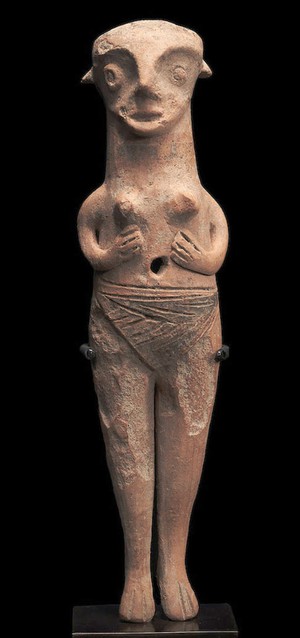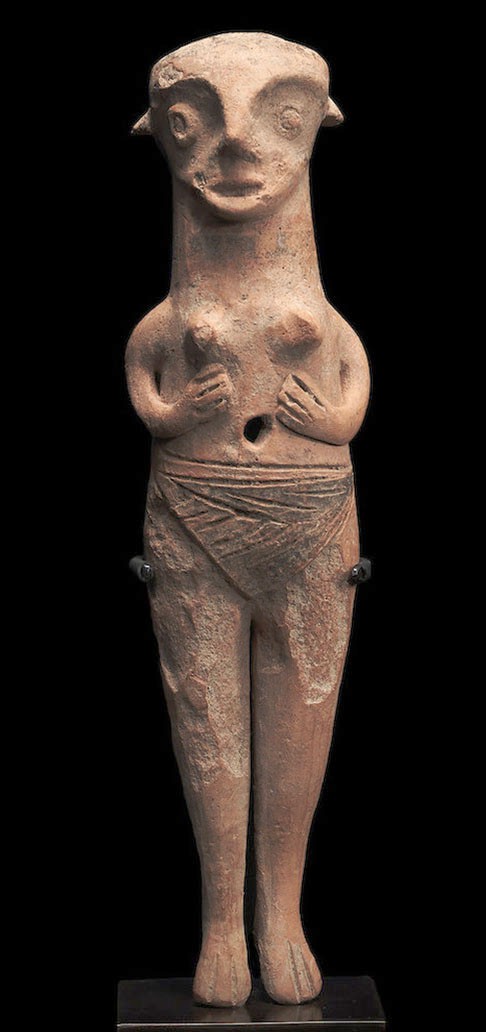Cypriot Flathead figure: Late Bronze Age (1450 - 1100 BC)
Base Ring Ware, Late Bronze Age female figurine. Like the earlier plank figures they are found equally both in tombs and the rubbish and floor-fill of settlements. These "Pubic Triangle" figures or "Astarte" figures are almost exclusively female and are of two standard types. This type are called “Flathead” figures (or “Headgear” figures by D Morris), and the others with enormous ears and earrings and bird like faces are “earring” or "birthed" figures. Both types (but the Earring figures especially) seem to be derived from North Syrian Syro-Hittite figures which themselves derive from Babylonian figures of Ishtar, and are related to the Phoenician Astarte, the fertility goddess whose Greek equivalent was Aphrodite who, like Astarte was supposedly born on Cyprus. However the North Syrian examples are much earlier, so the source can only have been heirlooms or a folk memory. V Karageorghis has suggested the flathead type have also been influenced by Mycenaean images, and it has also been suggested that flathead figures relate to the iconography of the Egyptian god Hathor who was associated with metal-working. These figures are indeed usually found at sites of small scale copper production. Bull shaped jugs, and hollow bull figurines have also been found in association with these areas.
The two types remained discrete and unchanged for 300 years and about 110 examples are known of each, along with over 400 bull vessels and figurines, the other main types of figurine. Although there are often more than one human figurine in a tomb (possibly because of multiple burials) there are almost never both types found together. There seems to be an allegiance to one or the other. The bulls, however are found equally in both. Both Type of naked female figure have, until recently, always been identified as fertility goddesses, or at any rate fertility figures, and this certainly fits the way they look, with heavy emphasis on the pubic triangle (as it never did the Earlier plank figures).
In contrast to plank figures the femaleness is very explicit, especially in the very wide hips of the earring type, and the pubic triangle is always emphasised with an incised double outline and hatched (or sometimes zig-zag) in-fill. They are sometimes seen as Fertility figures and sometimes as a female companion for the deceased, standing in for his wife. The pose is thought to be one of worship, but many of the Earring figures and a few of this type are depicted with babies in their arms. It is suggested that these figures lay on their backs by the body of the deceased (the pointed feet would not be conducive to it standing up, and the most protruding points of the back - back of the head, buttocks, heels etc - are in a straight line as though intended for a flat surface). The back is fairly plain and was roughly shaped by shaving the clay (like the bull above). A few of the figures of this type are depicted as leaning back, sitting on stools. The male figure is normally only present in these tombs as male animals with horns, principally bulls. The designation as Base Ring ware refers to the use of the same very fine grained clay used in Base Ring ware pots. The figure is hollow and the emphasized navel presumably functioned as a vent hole during firing. However it is hard to resist the feeling that the navel's original link to the mother is relevant and that this dark hole into an unseen interior is somehow symbolic. The figures are not coloured all over with paint or slip like other base ring wares, but left pale buff, more akin to flesh colour. There are one black and 2 red painted choker-like ring of paint around the neck as well as a painted pubic triangle. The top of the head above the ears is, as usual, painted black. Most likely this is hair as a curl also continues down in front of the left ear, reminiscent of depictions of Hathor in Egyptian art. However the flat top has also been seen (for example by Desmond Morris) as a cap pushing down the ears. In trying to explain the ears another way it has been pointed out that they are identical to the depiction of ears on bulls, the animal chiefly depicted in tombs and temples. Could this have been deliberate? The eyes of both are also depicted identically.
There is some surface wear and chipping, especially on thighs and head and some minimal encrustation. The figure has been broken, and expertly repaired, across the neck, hips, and above the ankles. There may be some restoration around the feet.
Size: 20cm H
(Ex American Private collection Tennessee USA 1970s 80s (with letter from deceased collector's daughter). He particularly collected such "idols" or fertility figures.)
(Aquired Bonhams Auction 30.09.2015 lot 29)
DJ44

